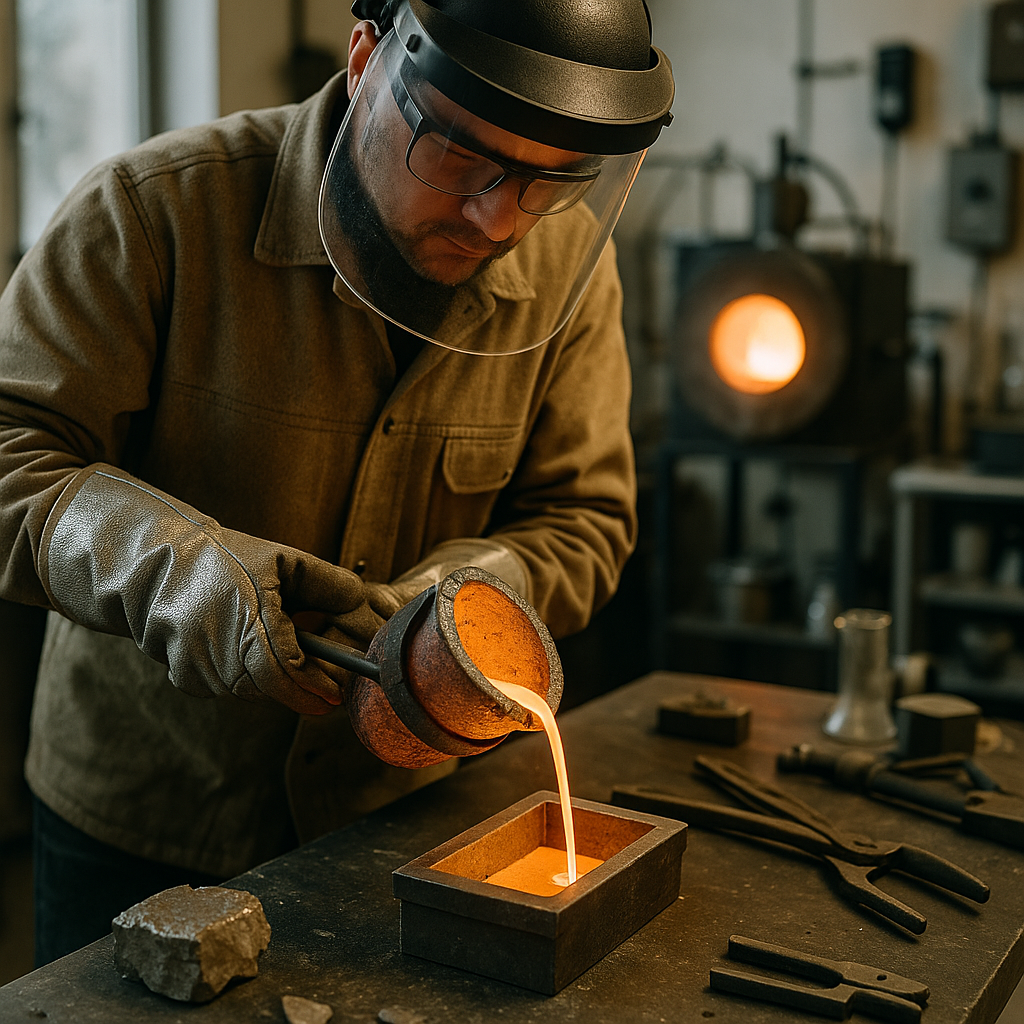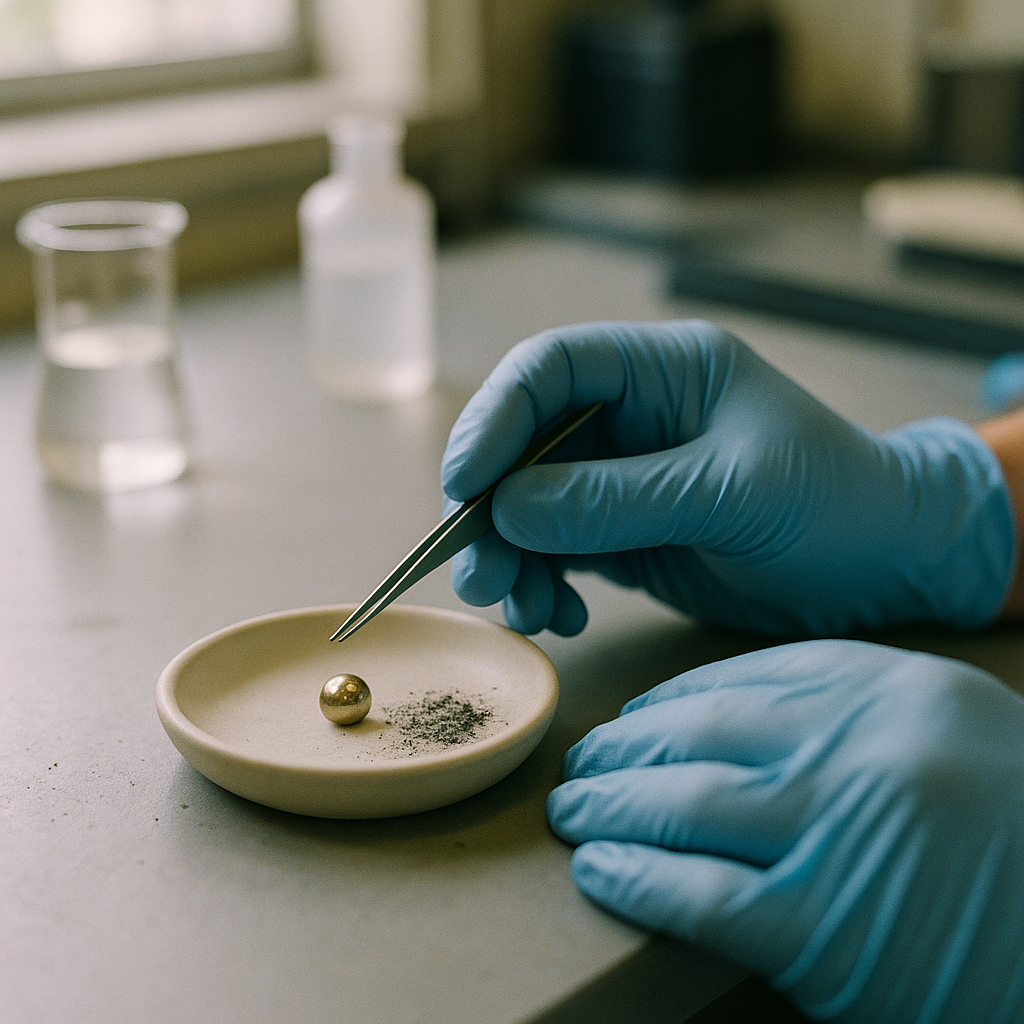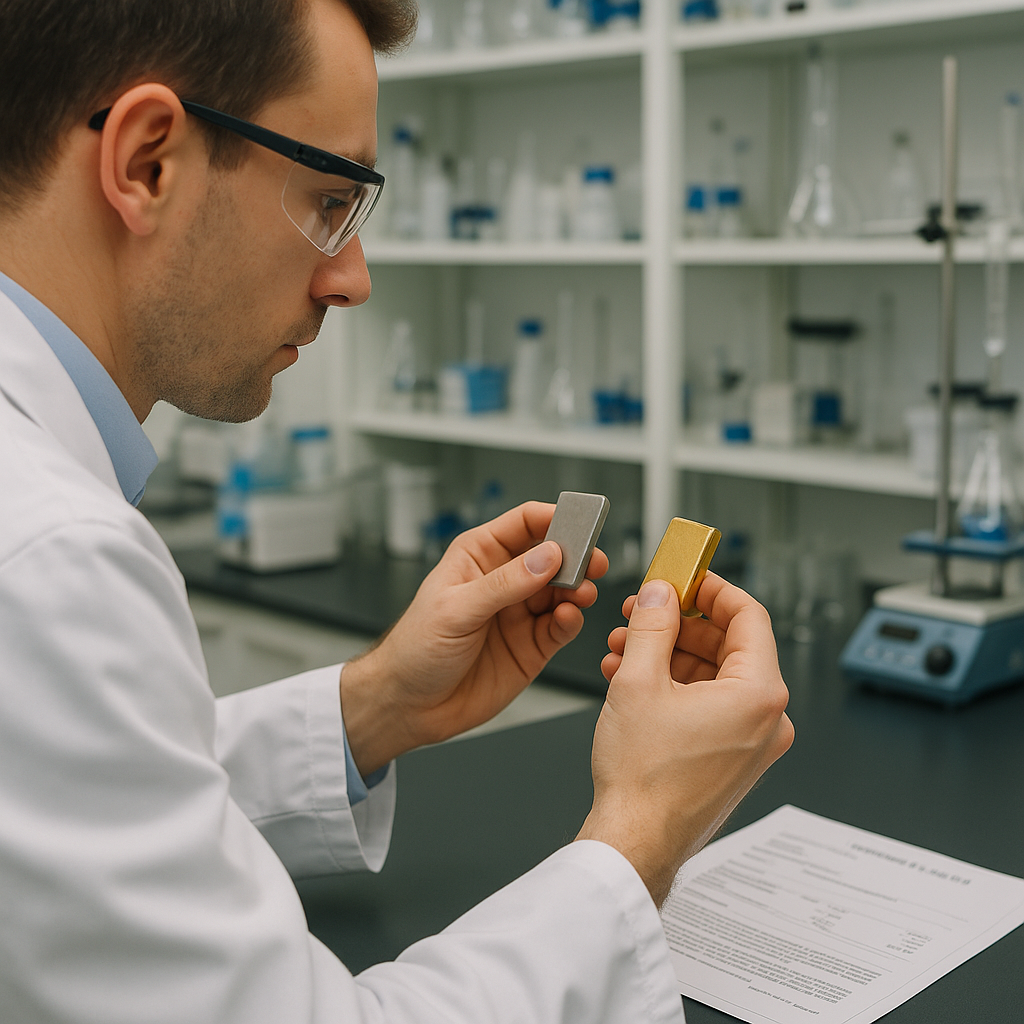5901 Botham Jean Blvd, Dallas, TX 75215
What is Precious Metal Assaying? A Guide to Methods & Applications
November 5, 2025Every piece of electronic waste, jewelry scrap, or industrial material entering our recycling facility contains hidden value. The precious metal assaying process, or metallurgical assay, is a compositional analysis of an ore, metal, or alloy to test for purity and quality. This scientific evaluation determines the precise content of valuable metals like gold, silver, and platinum within mixed materials.
Different assaying methods serve specific purposes in the recycling industry. Raw materials like bullion require distinct testing approaches compared to finished goods such as jewelry or electronic components. The process involves analyzing samples to measure metal concentration, fineness levels, and overall composition. These measurements directly impact material valuation and processing decisions.
What Are The Common Assaying Methods?
Materials recovery facilities and recycling operations rely on several established assaying techniques to determine precious metal content. Each method offers distinct advantages depending on the specific requirements of the waste stream and the level of accuracy needed for proper valuation.
The touchstone method is one of the most accessible non-destructive techniques available to recycling operations. This approach involves rubbing the metal item against a specialized testing stone, typically made of black basalt or slate, and then applying various acid solutions to observe the reaction patterns. Skilled technicians can detect differences in precious metal content as small as 10 to 20 parts per thousand using this method.
Recycling facilities often prefer this technique because it requires minimal equipment and can test jewelry, electronic components, and other materials without causing damage. The process involves comparing the acid reactions of unknown samples against reference materials of known purity. However, operators must handle hazardous acids carefully and maintain proper ventilation systems to ensure worker safety.
X-ray fluorescence spectroscopy offers another widely adopted non-destructive method in materials recovery operations. XRF analysis provides rapid results, typically within three minutes, with accuracy levels of 2 to 5 parts per thousand. This method works by measuring the characteristic fluorescent X-rays emitted when a sample is exposed to high-energy radiation.
The technology is particularly valuable for processing large volumes of mixed precious metal scrap. XRF analyzers can detect multiple elements simultaneously, making them efficient for sorting complex electronic waste streams. The non-destructive nature preserves material value while enabling accurate assessment for downstream processing decisions.
How Does The Fire Assay Process Work?

Fire assay is the most reliable method for determining the precious metal content in processed materials. This centuries-old technique delivers unmatched accuracy through a series of controlled heating and separation steps. The process converts complex waste materials into pure metal beads, allowing for precise measurement and analysis.
The fire assay method starts with careful sample preparation. Materials are crushed into a fine powder to ensure uniform mixing with chemical reagents. Sample sizes typically range from 10 to 30 grams, depending on the expected precious metal content. Visual inspection helps determine the appropriate weight and flux composition for optimal results.
Fusion Stage: Creating the Lead Button
The fusion process begins by mixing the powdered sample with specific fluxes in a fire-resistant crucible. The standard flux mixture includes litharge (lead oxide), sodium carbonate, borax, and silica. Each chemical serves a distinct purpose. Litharge provides the lead needed to collect precious metals, sodium carbonate acts as a basic flux to neutralize acidic materials, and borax aids in creating fluid slag conditions.
This mixture is heated in a furnace to temperatures exceeding 1000°C. At these temperatures, chemical reactions separate the precious metals from waste materials. The lead oxide reduces to metallic lead, forming small droplets throughout the molten mass. These droplets act as collectors, attracting and dissolving gold, silver, and platinum group metals.
During fusion, the molten material forms two distinct phases. Heavy lead containing the precious metals settles at the bottom of the crucible, with a lighter slag of silicates and borates above, absorbing unwanted impurities. The fusion process typically takes 45 minutes at temperatures between 1950 and 2000°F.
After heating, the molten mixture is poured into a conical iron mold. As it cools, the dense lead button separates cleanly from the slag layer, which is removed by hammering. The resulting button, weighing between 15 and 35 grams, contains nearly all precious metals from the original sample.
Cupellation: Isolating Precious Metals
Cupellation removes the lead collector to reveal pure precious metals. The lead button is placed into a cupel, a porous container made from bone ash or calcium phosphate, essential for the separation step.
Inside a muffle furnace, the cupel with the lead button is heated to cupellation temperature. Controlled airflow creates oxidizing conditions that convert lead to lead oxide (litharge), which the porous cupel absorbs, with some volatilizing into the furnace atmosphere.
Temperature control is critical during cupellation, with consistent heat ensuring steady lead oxidation at approximately one gram per minute. Excessively high temperatures can lead to precious metal losses through volatilization, while low temperatures result in incomplete lead removal.
When cupellation nears completion, characteristic visual changes occur. A rainbow effect appears on the lead surface as the final litharge moves rapidly across the molten metal, followed by a momentary dulling and a bright flash called the “blick,” signaling the completion of cupellation.
Formation of the Doré Bead
After cupellation, a small bead containing concentrated precious metals is left behind, known as the doré bead, which typically weighs only 2 to 3 milligrams despite the original sample being 30 grams or more. This concentration allows precise measurements of low precious metal concentrations.
The doré bead contains gold, silver, and platinum group metals in their pure metallic form. It is carefully removed from the cupel, and any adhering cupel material is cleaned from its surface, with proper handling preventing losses at this critical stage.
The doré bead is weighed using sensitive microbalances capable of measurements to fractions of milligrams. For individual metal determination, the bead is subjected to parting processes that separate gold from silver using nitric acid dissolution.
What Happens After Cupellation?

The cupellation process produces a precious metal bead containing both gold and silver in most recycling applications. This bead represents the concentrated valuable materials recovered from electronic waste, jewelry scraps, or other precious metal-bearing materials. The next crucial step involves precise analysis to determine the exact composition and value of these metals.
Professional recycling facilities weigh the metal bead immediately after cupellation using a high-precision balance. This initial measurement provides the total weight of precious metals recovered from the sample. However, determining individual metal content requires additional separation to distinguish between the gold and silver components.
The Parting Process
Parting is the definitive separation method for gold and silver in metallurgical analysis. This process relies on the chemical differences between these metals and their varied reactions to acids. The term “parting” originates from traditional metallurgy and describes separating gold from silver through selective dissolution.
The metal bead undergoes treatment with nitric acid, which acts as the separating agent. Nitric acid dissolves silver completely while leaving gold untouched. This occurs because silver readily forms silver nitrate when exposed to nitric acid, while gold remains inert under the same conditions.
Step-by-Step Separation Process
The parting procedure begins with placing the metal bead in a controlled environment where nitric acid can work effectively. The acid dissolves the silver portion of the bead, creating a solution containing silver nitrate. Meanwhile, the gold remains as a solid residue that maintains its metallic form.
After the acid treatment is complete, recycling technicians separate the undissolved gold from the silver-containing solution. The gold is thoroughly washed with distilled water to remove any remaining acid traces or silver compounds. This washing continues until the rinse water shows no signs of contamination.
The cleaned gold residue is then completely dried and weighed on a high-precision balance. This measurement represents the pure gold content of the original sample. The analytical finish of this process typically achieves accuracy levels that meet industry standards for precious metal recovery.
Calculating Silver Content
Determining silver content uses a calculation rather than direct measurement. Technicians subtract the final gold weight from the initial total precious metal weight obtained after cupellation. This difference represents the silver content of the original sample.
Some advanced recycling facilities supplement this calculation with further verification methods. ICP-MS analysis can confirm the accuracy of the parting results and detect trace amounts of other precious metals in complex electronic waste materials.
The parting process provides recycling operations with precise data needed for accurate material valuation and proper settlement with suppliers. This information guides decision-making for processing efficiency and helps facilities optimize their recovery procedures for various types of precious metal-bearing waste streams.
What Are The Main Industrial Applications Of Precious Metal Assaying?

Precious metal assaying serves as the backbone of numerous industries that depend on accurate metal content verification. From mining operations to electronics manufacturing, assay results drive crucial business decisions and ensure regulatory compliance. The precision required across these sectors makes professional assaying services vital for maintaining quality standards and protecting valuable investments.
Mining and Exploration Applications
Mining companies rely heavily on assay results to evaluate ore deposits and inform exploration decisions. Fire assay methods determine gold concentrations and assess the economic viability of potential mining sites. During operations, regular assaying tracks metal recovery rates and guides processing adjustments.
The accuracy of these measurements directly impacts investment decisions and stock valuations. High-value mineral content in assay results can significantly boost company valuations and attract more investment. Conversely, poor results may lead to project abandonment or stock price declines.
Jewelry Industry Quality Control
Manufacturers and dealers in the jewelry sector depend on assaying to verify the purity of gold alloys and raw materials, ensuring compliance with quality standards and maintaining consumer trust in finished products. Testing is particularly valuable for evaluating both incoming materials and completed jewelry pieces.
Quality control protocols in jewelry manufacturing require precise measurements to meet strict purity standards in line with existing investment contracts. Independent assayers play a critical role in ensuring settlements between parties based on accurate analyses. These services help jewelry companies avoid costly disputes over material quality and pricing.
Refining and Trading Operations
Refineries perform daily assay testing to determine precious metal content in various materials. These results underpin trading, pricing, and certification of bullion and other valuable items. Independent assay services facilitate settlement agreements between counter-parties, ensuring confidence in precious metal valuations.
Certificates of analysis detail sample purity and composition, providing essential transparency for trading and refining transactions. These documents serve as verified records of metal quality, establishing accurate marketplace values. Rigorous quality control protocols by assay companies minimize errors and maintain certification integrity.
Automotive and Industrial Catalyst Analysis
Catalyst manufacturers rely on assaying to measure precious metal loading in automotive catalytic converters and industrial catalysts. These measurements help control production costs while ensuring product quality meets environmental regulations. The analysis is crucial for catalyst recycling operations that recover valuable metals from spent units.
Automotive catalyst recycling is a significant application for precious metal assaying services. Recovery operations must accurately determine palladium, platinum, and rhodium content to maximize returns from spent catalyst materials. This analysis enables recyclers to offer competitive pricing while maintaining profitable operations.
Electronics Manufacturing Applications
Electronics manufacturers use assaying to verify gold content in components and maintain precise specifications for electronic connections and circuitry. The process ensures components meet required conductivity standards and performance specifications. Quality control measures help prevent costly product failures and warranty claims.
Electronic scrap analysis has become increasingly important as manufacturers focus on sustainable practices and material recovery. Assaying helps quantify precious metal content in electronic waste streams, supporting recycling initiatives and resource conservation efforts. This application promotes circular economy principles by enabling efficient metal recovery from end-of-life electronics.
Environmental Monitoring and Compliance
Environmental laboratories conduct fire assays to measure trace amounts of precious metals in soil and water samples. This monitoring helps assess contamination levels and ensures compliance with environmental regulations. The analysis supports remediation efforts and helps protect ecosystem health in mining areas.
Regulatory compliance requires precise measurement of metal concentrations, particularly when certain metals, even at low concentrations, indicate high pollution levels. Environmental assaying supports sustainable mining practices and helps companies fulfill their environmental stewardship commitments. These services are essential for ongoing environmental monitoring and reporting requirements.
The Standard for Precious Metal Analysis

The precious metal assaying process is crucial for determining the purity and value of metals across various industries. While non-destructive methods like XRF offer speed, the fire assay method remains the most trusted and accurate technique for precise analysis. This time-tested process delivers accuracy between one part per thousand and one part per ten-thousand, making it the gold standard for purity verification and quality standards in metallurgical testing. Through the meticulous steps of fusion, cupellation, and parting, fire assay provides reliable data that businesses in mining, refining, and jewelry rely on for accurate analysis and precious metal value assessment.
Whether managing industrial waste streams containing precious metals or requiring reliable testing for sustainability compliance, proper analysis forms the foundation of effective materials recovery. Contact Okon Recycling at 214-717-4083 for comprehensive recycling solutions that help maximize the value of your precious metal waste streams.
